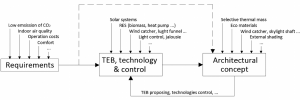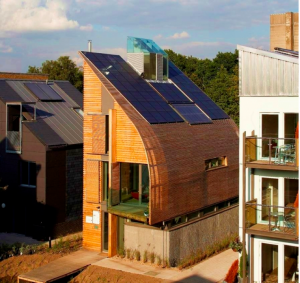Technologies change architecture
22. Jún, 2012, Autor článku: Števo Stano, Elektrotechnika, Strojárstvo
Ročník 5, číslo 6  Pridať príspevok
Pridať príspevok
![]() Paper presents the relation between technologies and architecture in the view of intelligent buildings. The comparision of linear “classical” and iterational proposes of building concept shows the consequecne of bad architectual concept into high technology demands. The basics of life cycle assessment are demonstrated on zero carbon house example.
Paper presents the relation between technologies and architecture in the view of intelligent buildings. The comparision of linear “classical” and iterational proposes of building concept shows the consequecne of bad architectual concept into high technology demands. The basics of life cycle assessment are demonstrated on zero carbon house example.
Inappropriately designed building both architecturally and technologically with superb control and technology, will still be a poor building, although with excellent control. The characteristics prove to be worse than the building with optimal proposition without control system or with a simple control system. Therefore, it is essential that architectural concept should be tied up closely with technology and vice versa. For specific requirements – passive house/zero house, the architecture is created by requirements for the building with energy modesty and its source, as well as by using innovative technical equipment for the building.
Zero – CO2 production.
There are many buildings which “architectonic” concept is tied-up closely with the requirements of creation of so called intelligent building [1][2] or the building, which fulfill other specific demands (a passive house, green building, etc.). One such study is the Zero-carbon Barratt House also called the Lighthouse located in Watford (England), developed by BRE (Building Research Establishment).
The heart of the concept for the Lighthouse is the ambition to create homes where the innovative environmental systems and construction methods do not compromise the quality of the occupants’ life but add to it – creating adaptable, flexible spaces that are designed for sustainable modern living. “Lighthouse” has two bedrooms and a total floor area of two and a half story, with approx 100 square meters.
Specific requirements are reflected in the architecture of the house, which solve some of the things a little differently from the standard model of housing, such as the location of sleeping area at ground level. Residential areas are located at the top floor, where they can use the most of natural light coming through windows and skylights.
House has been designed in line with Lifetime Homes and Housing Quality indicators. The home boasts high levels of thermal insulation, passive cooling and ventilation, biomass boilers and so on. Biomass boilers run on organic fuels such as wood pellets and count as zero-emission because, the amount of carbon dioxide they give off when they are burned is offset by the amount that was absorbed when the crop was grown. (*The term “zero” is pure marketing designation, due to the fact that it is not evaluated in view of LCA[3]).
The house has a waste sorting system that allows burning combustible waste and also uses solar system as a solution for water heating, solar cooling, photovoltaic energy and heat pump. (all technologies used are suitable for integrating in new or even existing buildings). This building is a strategic step towards the house with low or zero-carbon *.
Architecture
It reflects the use of specific technologies as well as the actual requirement of creating buildings with low carbon production. The home has a simple; “barn-like” form with a 40 degree pitched roof that includes solar panels and rainwater harvesting. The sweeping roof envelops the central space – a generous, open-plan, top-lit, double height living area, with the sleeping accommodation at ground level. The living space uses a timber portal structure. Stability is achieved through the moment connections at first floor and ceiling level. It is constructed using Kingspan Off-Site’s TEK Building System – a high performance SIPS (structurally insulated panel based system).
For the Lighthouse, this will provide a high level of thermal insulation and performance reducing the heat loss by potentially two-thirds that of a standard house. U values of 0.11W/mK and air-tightness of less than 1.0m/hr/m at 50Pa. The foundations consist of off site timber floor cassettes on a ring beam of timber beams supported off the ground level by screw fast pile heads. The piles provide minimal disturbance to the ground and provide suitable supports for domestic scale dwellings. When the building reaches the end of its useful lifespan, the fast foundation support point can be removed. [4]
Selective thermal mass
Phase changing material in the ceilings absorbs the room heat by changing from solid to liquid within microscopic capsules embedded in the board. This process is reversed when the room is cooled with the night air, working with the passive system of the wind catcher.
Wind catcher/light funnel
Located on the roof above the central void over the staircase, the wind catcher provides passive cooling and ventilation. When open, this catches the air forcing it down into the hearth of the house in to the living space on the ground floor dispersing the hot air and slowing it to escape. The wind catcher also brings daylight deep into the depth of the house and provides the ground floor sleeping accommodation with secure nighttime ventilation.
Services and energy
Integrated with smart metering and monitoring that records energy consumption and enables occupants to identify if any wastage is occurring, thereby helping to promote more environmentally aware lifestyles. A biomass boiler provides renewable energy with an automatic feed system for heating. Photovoltaic provide all electricity for the home and a solar-themed array, which supplies hot water and allows the boiler to be turned off in the summer.
The roof-mounted wind catcher provides secure nighttime ventilation for passive cooling, in conjunction with thermal mass boards in the ceilings and external shading. This helps to control the temperature of the interior environment, improving occupier comfort and keeping the house cool in the summer months. These renewable energy features have reduced energy fuel costs for space and water heating in the Lighthouse to around 50 € per year and, as all electricity is supplied via solar technologies, electricity running costs are completely eliminated. The overall cost of fuel in each house has been reduced by about 94% (not including standard charges). Time horizon for return on investment, however, is likely to exceed the lifetime of building (this fact usually occurs always in development solutions), but just such a development studies undercut subsequent wider solutions use.
Architecture vs. Technology
As was showed on the example of the “zero” house – Lighthouse, in the case of “smart” buildings (houses) that determine the direction of sustainable housing, where energetic and functional requirements precede the architecture. In mentioned concept, the architecture is resulting from the technical specifications of the building. Architectural concept is therefore necessarily based on the selected technologies, energy sources and energy requirements. Architecture most of all affects the behavior of building, which modifies the requirements for used technologies, control and equipment. This creates a circle, respectively. spiral at the end of which is the optimal solution.

(TEB – Technical equipment of building, RES – required energy sourses)
With mentioned approach we can create a better solution (in terms of the indoor environment quality, energy and environmental requirements…) as a classic approach to building design. Classic approach of building design process considers creating architectural (structure and design) solutions without any special regards on technologies. Subsequently from “architectonic” concept the determined requirements were designed with focus on energy and their requirements of the used technologies as a heat input, ventilation rate exchange, energy etc. Based on these requirements engineers proposed the parameters of building equipment technologies (lighting, HVAC…) and the last step is the automation control that has only a minor affect of the final characteristics of the behavior of the building.
It is important to realize that intelligent low-energy (eco-smart) building (construction)[1][2] is created primarily of architecture – passive parts of building (i.e., passive elements most impact on energy balance – mass selective temperature, wind catcher / light funnel, etc.). These elements do not require any additional power or control system making them highly reliable (no need for solving the case “total blackout” and so on.) Control Engineering only completes the architectural concept, respectively. It extends the possibilities of automation and HVAC building services. Architectural concept should therefore essentially incorporate requirements, demand and limitations of used technologies and an accessory with the control demands and not vice versa.
References:
- Števo, Stanislav: Trendy v oblasti inteligentných budov. In: Eurostav. – ISSN 1335-1249. – roč.17, č.3 (2011), s. 18-20
- Puskár, Branislav: Inteligentne budovy na byvanie.-Bratislava: Verlag Dashofer, 2008.-60s.
- Ciambrone, D. F., Environmnetal life cycle analysis, CRC-Press; 1 edition (October 11, 1997),
- Shepherd Robson, Lighthouse Zero Energy Home, Ben Reed, 2009,
- Project Lighthouse Zero Energy Home (UK),
www.solarpedia.com - S. Singh, B. R. Bakshi (2009). “Eco-LCA: A Tool for Quantifying the Role of Ecological Resources in LCA”. International Symposium on Sustainable Systems and Technology: 1–6. doi:10.1109/ ISSST.2009.5156770. ISBN 978-1-4244-4324-6



